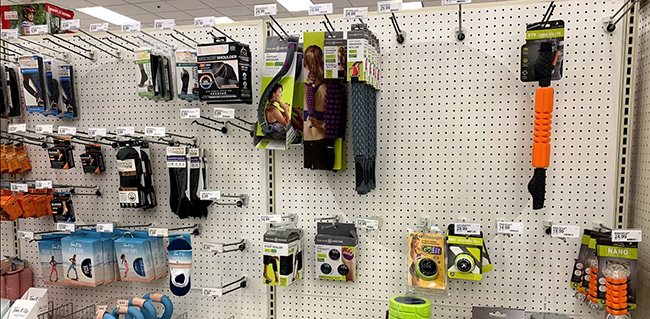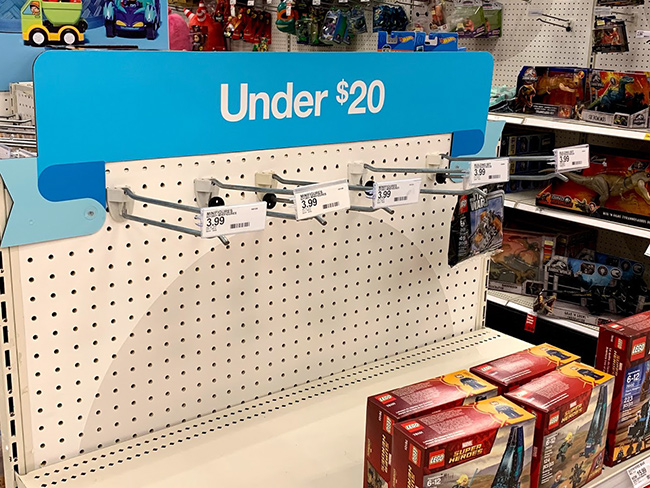
Store Inventory Struggles: Pegging the Problem with Store Traffic
Editor's Note: Dave walks approximately six million steps (3,000 miles) a year in an attempt to stave off the ravages of Father Time. The vast majority of those steps are taken in and around the sidewalks of suburban retail, where he conducts much of his market research. This is the third post in his series of observations from the streets of retail.
Last week, I came face to face with what just may be the biggest reason why store traffic continues to suffer. I experienced first-hand just how bad inventory management has become, even inside stores of the biggest names – with the biggest inventory budgets – in the retail industry.
However, before we talk shop (literally) allow me to set the scene for you: It's early on a Saturday morning in Encinitas, California, and I am preparing to walk to the local schoolyard for a pick-up basketball game. As I reach for my basketball, I realize it's a little bit soft, so I grab my pump to re-inflate the ball. As soon as I start, however, the inflation needle breaks. And of course, it's my last needle. So I need a replacement, and I need it in a hurry (if I want to make my weekly game). Fortunately, I live within a 2-mile walk of at least three big-box stores that could – theoretically – sell me my inflation needle that very morning.
I immediately grab my phone to see which of the three might have the needle I needed. One carries the needle, but it won't be available to me for ten (yes, ten!) days. More on that in a moment. But for now, back to my search: The second nearby store won't even open for a couple more hours. So I tap over to the third store's web site. And, bingo! They offer the needles I need, and they have them in stock. So off I walk, content in the knowledge that I won't miss my Saturday morning hoops.
Or so I thought.
A sad store inventory surprise
Sadly, and despite web site promises to the contrary, the needle I needed was not in stock. Which was a bummer, to be sure, but not the end of the world - or my relationship with that retailer. While certainly disappointed to miss my hoops game, I couldn't really fault the retailer for an inventory error on an 89-cent item.
But what I found in that store that day was far worse than an isolated inventory mistake. That store was positively decimated. Here I was, on an always-busy Saturday morning, mere minutes after they opened, and I was surrounded by empty pegs, empty racks, empty shelves…and empty shopping carts. For a minute, I wondered if the government had just announced some new tariff which had caused a run on the sporting goods and toy departments.
[caption id="attachment_16265" align="alignnone" width="650"] Empty pegs were everywhere, making one wonder if there had been an unexpected run on toys and sporting goods[/caption]
Empty pegs were everywhere, making one wonder if there had been an unexpected run on toys and sporting goods[/caption]
But alas, there were no good explanations. This store had just wildly mismanaged its inventory.
Pegging the Store Traffic Problem
Everywhere I looked, pegs were empty and shelves had been forsaken. Even on many high-visibility/high-value endcaps, most topped with signs promoting the great value of the items they (allegedly) housed, the cupboards were bare. And I do mean bare. One particularly egregious endcap, with peg capacity for at least 50 Star Wars characters, contained just one lonely Stormtrooper, hanging by a thread, on a long, lonely peg hook.
[caption id="attachment_16262" align="alignnone" width="650"] One sole Stormtrooper looks lost and lonely amid a galaxy of empty hooks on an end cap one recent Saturday morning[/caption]
One sole Stormtrooper looks lost and lonely amid a galaxy of empty hooks on an end cap one recent Saturday morning[/caption]
I suppose I shouldn't have been surprised, but I admit I was shocked by this sad state of affairs. I am a notoriously ruthless planner, so I rarely shop for anything - other than food - that I need on a moment's notice. So I was positively blindsided by my inability to complete this urgent, but supposedly simple, shopping mission.
I certainly know that store inventory accuracy and availability reporting is still a significant industry-wide challenge. But I guess I had assumed that the biggest budgets in the business would be able to maintain better in-stock positions than what I experienced that day.
And I only have one question for that first store's promise of getting me my needle in 10 days: Who, exactly, is willing to wait ten whole days for anything anymore?
Not Rocket Science
What is especially unsettling is that they are not challenges that require cutting-edge technology to solve. These challenges can be overcome by technology that's been available for decades. Store inventory problems like I experienced that day can be minimized – or eliminated – by long-proven forecasting, allocation and replenishment solutions. These two retail giants have each spent tens of millions of dollars over many years trying to fine-tune these solutions in an attempt to optimize their store inventory positions.
But perhaps therein lies the rub, no?
In our push to "optimize" store inventory, I fear we may we have gone too far. I can think of no other plausible explanation. Inventory problems of this magnitude are not caused by simple inventory reporting issues or unexpected fulfillment demand. These are systemic and far-reaching stock-outs. Is it possible that we are over-tuning inventory and putting more stock-outs in play, all in the name of preserving margin dollars?
It seems we are.
And we simply have to do better. We have to look at stock positions and store inventory plans at an item level, and we must consider the visual impact of overly-tuned assortments. It's hard enough getting people into our stores. We definitely can't afford to turn away ready-to-buy shoppers because we just don't have the stock they need on hand.
Unfortunately, however, it appears that this problem may have already gotten out of hand.

